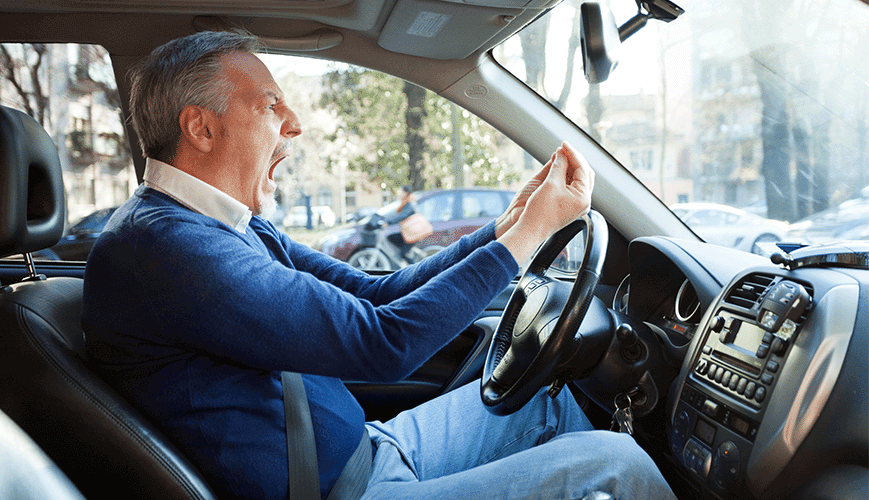Turn the Commute from Hell into Something Swell
By Sara Butler

Traffic -- it’s the curse of the modern age. Well, that and the band Nickelback.
If you’re anything like me, you read in horror about the bridge collapse on I-85 in Atlanta. As if traffic in Atlanta wasn’t already something described by Dante’s Inferno, this added complication has to be a nightmare for the fine folks in and around Atlanta.
But we all know traffic issues aren’t just something plaguing the home of the Braves (and those poor Falcons). From sea to shining sea in this fine country of ours, you can be certain to get stuck in traffic during rush hour. At The Joint Chiropractic, we take these issues seriously because if you spend any amount of time in your car getting to and from work, then you should be concerned about your health and well-being.
"We are always concerned about the rigors of traffic on the health of its community," says Dr. Patrick Greco of The Joint Chiropractic - Atlanta. “Our traffic situation in Atlanta highlights the need for proper spinal education and adjustments to reduce the odds of chronic health issues arising down the road. That’s a sentiment shared among all chiropractors at The Joint nationwide.”
Here are a few tips you can use to turn that commuter frown upside down and use it as an opportunity to improve your health, whether you’re traveling by car or bus.
Commutes: Literally, a Pain in the Neck
How can you avoid neck and back pain when you’re in the car, gripping the steering wheel with rage as you wonder why on earth there’s only one lane of traffic moving? First of all -- breathe! It’s all going to be OK.
Now that you’re a bit more relaxed, you can try to avoid back and neck pain by:
- Utilizing the headrest – The headrest on the back of your seat isn’t just for decoration, so use it. Don’t crane your poor neck forward, but instead rest your head against it and relax a little bit. It’ll help your neck from getting sore.
- Keeping laid back – Channel your inner Snoop Dogg and make sure you lean back in the seat, since slumping or hunching will only increase pressure on your spinal discs and contribute to back pain. The best thing you can do is sit upright and lean back slightly. This position has the added benefit of making you look cool and relaxed to other harried commuters.
- Yielding to the curves – Your back has natural curves and it’s your job to support them. Use a rolled up shirt or a small pillow to place between your lower back curve and the seat. This will help offer additional support to your back.
- Losing your wallet – Look, don’t actually lose your wallet, but take it out of your back pocket. Sitting on your wallet can create an imbalance in your lower back and hips and aggravate the sciatic nerve, leading to pain. Don’t aggravate your sciatic nerve, because its wrath can be worse than an angry wife or girlfriend!
- Keeping it in reach – Whatever things you need for your commute should be kept within arm’s reach. Water, sunglasses, a phone, and change for tolls -- whatever you need should be easy to grab so you don’t place unnecessary stress and strain on your spine or back muscles as you overextend to grab something. It will also help you keep your eyes on the road if you’re behind the wheel.
Keep Moving Even When Your Vehicle Isn’t
Since the average American will spend 50 minutes commuting every day, and the recommended amount of exercise you should be getting each day is 20 to 30 minutes, why not knock out two birds with one stone during your commute? You can squeeze in extra time during your commute to squeeze those abs with these exercises:
- Engage your core muscles – It’s not hard, all you have to do is tighten up your abs by attempting to draw your belly button into your spine. Contract your abdominal muscles and hold it for five seconds, then release. Repeat around 20 times. You can knock most of that out at a stoplight.
- Shoulder contractions – Sit as straight as you can and engage that core! Then stick your chest out as you pull your shoulder blades together. Hold that squeeze for five seconds, and then repeat 20 times. This exercise can help with your posture all the time!
- Spine stretch – Place your hands at 10 and 2 on the steering wheel (think back to your Driver’s Ed days) and bring your shoulders forward to round your upper back. This helps to stretch out the area between your shoulder blades. Take a breath, then release. Repeat 20 times.
Of course, you shouldn’t attempt these things while actually driving your car, but if you’re sitting in traffic, going nowhere, what have you go to lose?
Let’s face it, until you unlock the secrets of independent wealth, commuting and dealing with traffic will be a fact of life. But it doesn’t have to be wasted time when you can use it to improve your health and tone up your muscles! Just keep Nickelback off the radio.
The information, including but not limited to, text, graphics, images and other material contained on this page are for informational purposes only. The purpose of this post is to promote broad consumer understanding and knowledge of various health topics. It is not intended to provide or be a substitute for professional medical advice, diagnosis or treatment. Always seek the advice of your chiropractor, physician or other qualified health care provider with any questions you may have regarding a medical condition or treatment and before undertaking a new health care regimen, and never disregard professional medical advice or delay in seeking it because of something you have read on this page.